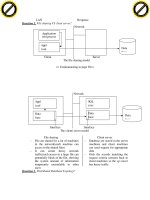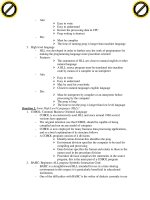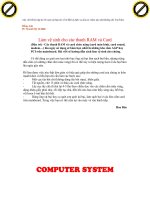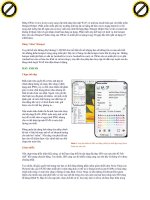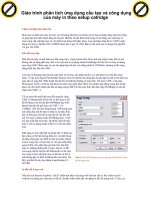Giáo trình hình thành toolset điều chỉnh cấu tạo và công dụng của máy in theo setup catridge p4 pptx
Bạn đang xem bản rút gọn của tài liệu. Xem và tải ngay bản đầy đủ của tài liệu tại đây (399.52 KB, 10 trang )
- Ads:
Easy to write
Easy to understand
Known the processing data in CPU
Prog writing is shortset
- Dis:
Must be complier
The time of running prog is longer than machine language
3. High level language
- HLL was developed in order to further easy the work of programmers by
making the programming language more procedure oriented
- Features:
The statements of HLL are closer to natural english or other
natural language
A HLL source program must be translated into machine
code by means of a compiler or an interpreter
- Ads:
Easy to wirte
Easy to understand
May be used for everybody
Closed to natural languages english language
- Dis:
Must be interpreter by compiler or an interpreter before
processing by the computer
The prog is long
The time to run the prog is longer than low level language
Question 2. Some High Level Languages (HLL)?
1. COBOL: Common Business Oriented Language
- COBOL is an exetensively used HLL and since around 1960 several
versions have appeared
- The original intention was that COBOL should be capable of being
compiled and run on any model of computer
- COBOL is now employed for many business data processing applications,
and so a brief explaination of its structure follows
- A COBOL program consists of 4 divisions:
Identifycation division this identifies the prog
Enviroment division specifies the computer to be used for
compiling and processing
Data division specifies the format and relates to these to the
names used in the procedure division
Procedure division comprises the statements in the source
program, this is the main part of a COBOL program
2. BASIC: Beginners ALL purpose Symbolic Instruction Code
- BASIC is a straightforward HLL intended for use in a time-sharing
environment in this respect it is particularly beneficial in educational
institutions
- One of the difficulties with BASIC is the welter of dialects currently in use
Click to buy NOW!
P
D
F
-
X
C
h
a
n
g
e
V
i
e
w
e
r
w
w
w
.
d
o
c
u
-
t
r
a
c
k
.
c
o
m
Click to buy NOW!
P
D
F
-
X
C
h
a
n
g
e
V
i
e
w
e
r
w
w
w
.
d
o
c
u
-
t
r
a
c
k
.
c
o
m
- Essentially BASIC consists of statements made up of verbs & variables.
The verbs are similar to those in COBOL but there is a large to them that
in effect become the addresses of their locations in the main store
- A variable name must be unique and generally consists of one or a few
alphabetic characters, purhaps followed by a digit
3. PASCAL: named after the famous 17
th
century French mathematician
- It was expressly designed as a language to make programming more
systematic and discriplired and in these respects lends itself to structured
programming
- It is however more difficult to learn than are COBOLS BASIC and so is
unliked to be accepted as a language for microcomputers are geared to
BASIC only
Question 3. Operating Systeim?
- Concept of OS:
An OS consists of a suite of programs, one of which, the
master, kernel or exeactive program, remains resident in the
main store. This program controls the other OS programs in
th suites and between them they controls the application
programs
Often the operating system includes various application
packages among its suit of programs. Ex of such software
include: word processing, electronic mail, networking,
speadsheet, graphics and file handling
- Function of OS
Pricrity assignment:
Jobs waiting execution are scheduled according to either a predetermined or a
dynamic assignments plan
Control of multiprogramming
Control of accomplish multiprogramming an “executive” or “supervisor” program
is employed to control the application programs
Communication
Control of data transmission between terminals and the computer, and computer to
computer
Database
Control of DBMS
Software control
Control of assemblers, compilers, utility software, and subroutines so that these
are imediately available when required
Spooling
The control of input/output peripherals in order to achieve their best utilisation
Dynamic allocation
Of main and backing storage, including virtual storage
Operating allocation
Via the console printer or VDU
Debugging and editing new programs
In confunction with the compiler, and passing error msgs to the user
Operation log
Maintaince of details of all jobs carried out by the computer
Click to buy NOW!
P
D
F
-
X
C
h
a
n
g
e
V
i
e
w
e
r
w
w
w
.
d
o
c
u
-
t
r
a
c
k
.
c
o
m
Click to buy NOW!
P
D
F
-
X
C
h
a
n
g
e
V
i
e
w
e
r
w
w
w
.
d
o
c
u
-
t
r
a
c
k
.
c
o
m
Application package control
Especially with microcomputers, as describe above
Chapter 6: TRANSLATORS.
Question 1. Translators?
1. Assemblers
Def: A program that translates assembly language into machine code. Dos
machine instruction is generated for each source instruction
- The resulting program ran only be executed when the assembly process is
completed
Operation:
- Translates mnemonic operation codes into machine code & symbolic
address into machine address
- Includes the neressary linkages for closed subroutines and inserts
appropriate machine code for macros
- Allocates area of storage
- Detects and indicates valid source language instruction
- Procedures the object program on tape or disk required
- The lesting may also include error codes if appropriate. To illustrate the
methods used just think about an assembly program. We must first look at
the directives
A directive is used to control the assembly process, it is not
asembled but is obeyed by the assembler when it is
encouteded, e.g ”END”, is sometimes called a pseudo-
operation code on pseudo-opcode
2. Interpreter
A program which translates and executes each source statement in logical sequence as the
program one instruction at a time, completely translating and executing each instruction
before it goes onto the next
- Interpreter, which deals with the source program one instruction at a time,
completely translating and executing each instruction before it goes onto
the next
- Interpreter seldom produce object code but call upon inbuilt routines
instead
- Some intermediate code is usually produced tempororily
- If an interpreter is used, the source program will be translated every time
the program is executed
- Interpreters are widely used, particular for the programming language
Basic on small computers
Interpriter are used for such things as:
- Handling user commands in an interactive sys
- Debugging programs as they run
- Handling software produced for or by a different computer
3. Compilers:
A program that translates HLL into a machine orientated language, often the machine
code. Many machine instructions are generated for each source statement
- The compiler:
Click to buy NOW!
P
D
F
-
X
C
h
a
n
g
e
V
i
e
w
e
r
w
w
w
.
d
o
c
u
-
t
r
a
c
k
.
c
o
m
Click to buy NOW!
P
D
F
-
X
C
h
a
n
g
e
V
i
e
w
e
r
w
w
w
.
d
o
c
u
-
t
r
a
c
k
.
c
o
m
Translates the source program statements into machine
code
Includes linkage for closed subroutines
Allcocates areas of main storage
Generates the object program on cards, tape and disc as
required
Produces a printed listing of the source and objected
programs when required
Tabulates a lish of errors found during compilation
- Compilers are commonly used for the translation of HLL program
- Compiler translates the whole of the HLL source program into a machine
code object program prior to the program being loaded into main memory
and executed
- If a compiler is used, the same program need only be translated once
Stages of compilation
lexical analysis
systatical analysis
code generation
Chapter 7: SOFTWARE.
Question 1. Application software?
- Application software comprises the programs that are written specifically
to achieve resulting appertaining to the company’s activities
- Application software comes from two source
They produce by themselves
Buy from an external agency
1. Ads and dis of using application packages in house
Ads
- The requirements of the application are more easily met
- There is more control in testing and debugging
- The more control over the usage and support obtained
Dis
- There is a waiting period before the application can be implemented
- Development cost is higher than buying a package
2. Ads and dis of using application package
Ads:
- The packages can be used immediately
- Documentation is generally good
- It can be used on a varisty of machines
- It is cheaper as the costs of the packages are shared between many users
- Comprehensive on line help information and guided tutorials available
- Easily remembered command syntax
- Can be used in confunction with other software in an integrated fashion
Dis:
- Modifications may be difficult for some applications
- Package may be two generalized to suit user needs
- Some features purchased may not be required
Click to buy NOW!
P
D
F
-
X
C
h
a
n
g
e
V
i
e
w
e
r
w
w
w
.
d
o
c
u
-
t
r
a
c
k
.
c
o
m
Click to buy NOW!
P
D
F
-
X
C
h
a
n
g
e
V
i
e
w
e
r
w
w
w
.
d
o
c
u
-
t
r
a
c
k
.
c
o
m
- Support given depends on stability and professionalison of the vendor
- User are required to comply with the owner’s regulations
Question 2. Utility software?
- Certain processing is common to a high proportion of computer users, and
so utility software has been created to cater for this need
- Utility software is intended to be sufficiently flexible to meet most user’s
requirements and is tailored to meet their precise needs by means of
parameter entered prior to use
- Some of the utility programs described below may be incorporated into the
OS that is used with a particular computer
File conversion: this convers the transference of data from
any medium to any other
File copying: an exact copy of a data set is made on to
another lot for the same type of storage medium
File reorganisation: direct access, files over flow records
are stored in designed blocked, this is acceptable up to a
point but from time it si necessary to reorganise the file so
as to remove the overflow
File maintenance(amendment): this procedure involves the
straightforward insertion and deletion of records into or
form sequential files
Sorting: is frequently necessary in order to arrange a set of
records into a certain sequence based on their key values
Dumping routines: a dump routine is used in confunction
with a restfirt program
House keeping operations: there are programs or parts of a
programs not directly concerned with the solution of the
problem in hand
Trace routines: these entails, the dumping, display or
printing of th program or other contents of the main store
during program testing to facilitate error detection
- Utilitys are commonly used to perform these functions:
Copying of files
Sorting of data
Merging of files
Data recovery
Reformating of records by reamanging their fields
File reorganization
Reporting of sys status and usages
Question 3. System software?
There are three main types of memory placement policy:
- First fit
- Best fit
- Worst fit
1. First fit policy, an incoming job is placed in the first available free space large
enough to fit it. This allows the placement decision to be made quickly
2. Best fit policy, an incoming job is placed in the free space in which it fits most
tightly
Click to buy NOW!
P
D
F
-
X
C
h
a
n
g
e
V
i
e
w
e
r
w
w
w
.
d
o
c
u
-
t
r
a
c
k
.
c
o
m
Click to buy NOW!
P
D
F
-
X
C
h
a
n
g
e
V
i
e
w
e
r
w
w
w
.
d
o
c
u
-
t
r
a
c
k
.
c
o
m
3. Worst fit policy, an incoming job is placed in the largest possible hole of free
space
Question 4. Types of scheduling?
- Scheduling of job is also an important part of any OS. It involves keeping
track of and deciding which job is to be executed
- Types of scheduling
Deadline scheduling
First in first out scheduling(FIFO)
Round robin scheduling
Shortest job first(STF) scheduling
Shortest remaining time scheduling(SRT)
- More details about types of scheduling
In deadline scheduling certains are scheduled to be
completed by a specifir time or deadline. Deadline
scheduling can be very complex requiring substantial
overhead in resource management
FIFO scheduling: processes are dispatched according to
their arrival time in the ready queue. This type of
Round robin scheduling is similar to FIFO scheduling but
the difference lies in that each job is given a slice of CPU
time
SJF scheduling: shorter jobs are more favoured than longer
one. SJF selects job that ensures the next jobs will complete
& leave the sys as soon as possible
SRT scheduling: the job will the smallest estimated
remaining run time is executed first. In SRT, a running job
may be replaced by a new job with a shorter estimated run
time
Chapter 8: MEMORY MANAGEMENT.
Question 1. Virtual Storage System?
- Instructions and data not currently needed might even be stored on the disk
and thus free up a portion memory
- Virtual storage systems have evolved to meet these needs. Virtual storage
systems allow programs to be as large as necessary, even larger that the
physical storage capacity of the computer
- Translating the user’s view of the program into the physical reality of
computer storage is one of the major task performed by virtual memory OS
like IBM’s MVS and digital VMS
- Virtual storage system included non paged systems
Paged systems
Chapter 9: NETWORKING.
Question 1. Types of network layout?
Network topology is the name given to the various types of network layout
1. Start network(or centralised network)
- This network all communications go through a central node
Node A
Node D
Central(Hub) active
Click to buy NOW!
P
D
F
-
X
C
h
a
n
g
e
V
i
e
w
e
r
w
w
w
.
d
o
c
u
-
t
r
a
c
k
.
c
o
m
Click to buy NOW!
P
D
F
-
X
C
h
a
n
g
e
V
i
e
w
e
r
w
w
w
.
d
o
c
u
-
t
r
a
c
k
.
c
o
m
Passtive
Node C
Node B
- The centra of star network is the hub which performs the function of
routing msgs and data within the network
- The hub manages & senvices all incoming and outgoing communication
traffic. It’s also provide info services from a large central data bases
2. Mesh network (or distributed network)
- This network may be fully connected or partially connected
A
E B
D C
- Data can get from one node to another node via different route
- Multi point to point
3. Ring network( or loop network)
A B
D C
- Work stations connect to the ring
- More cabling requiring than BUS
- The connectors used with a lot of problem
- Cable is used UTP, STP
4. Bus network( or multidrop network)
A B
- All workstations are connected the same cable segment
- Commonly used for implomenting ethenet at 10 mbps(Mb/s)
- The cable is terminalled at each end
- Writing is normally store point to point
- A faulty cable or work station will take the entire LAN down
Question 2. Network control?
Click to buy NOW!
P
D
F
-
X
C
h
a
n
g
e
V
i
e
w
e
r
w
w
w
.
d
o
c
u
-
t
r
a
c
k
.
c
o
m
Click to buy NOW!
P
D
F
-
X
C
h
a
n
g
e
V
i
e
w
e
r
w
w
w
.
d
o
c
u
-
t
r
a
c
k
.
c
o
m
1. Modems(modulation demodulation)
A telephone line B
Modem modem
Digital signal analog signal
OR
Data transmission Using a Modem
- To communicate between computers via telephone line, there is a need to
convert signals from the computer into a form suitable for transmission
over the telephone line or convert from digital signals into analogue
signals, and convert back from analogue signals to digital signals
- From source: digitals signals are converted into analogue
signals(modulation)
- At the received end analogue signals are converted back into digital
signals (demodulation)
- A device to handle modulation, demodulation process is called Modem
2. Bandwidth and Fibre Opties
The major benefits of fibre opties are:
- Fibre optic cables are much lighter and smaller in size
- Greatly increased speed in data transmission
- Greatly reliability
- Greater secerity as lines can not be tapped
3. Transmission
a. Simplex transmission
This method allows for transmission in one direction only
b. Half duplex transmission
This method means that’s data can be transmitted in both directions, but is only on
direction at a time
c. Full duplex trasmission
This method of transimission allows for transmission in both directions simultaneously
* Two modes of transmission are used when transmitting data over
communication lines. They are
asynchrorous
synchronous
Asynchronous:
- One character at a time is transmitted or received
- Each character is preceded by a start bit and a stop bit
The start bit is used to indicate or character is being sent
The stop bit is used to indicate the end of the character
- Asynchronous transmission is used for low speed devices
Direction of transmission
Com
pute
Com
pute
Mod
Mod
Click to buy NOW!
P
D
F
-
X
C
h
a
n
g
e
V
i
e
w
e
r
w
w
w
.
d
o
c
u
-
t
r
a
c
k
.
c
o
m
Click to buy NOW!
P
D
F
-
X
C
h
a
n
g
e
V
i
e
w
e
r
w
w
w
.
d
o
c
u
-
t
r
a
c
k
.
c
o
m
S S S S
T T T T
A 11000001 O 1111111 A 11000010 O
R P R P
T T
Synchronous:
- The speed of transmission is much faster
- Transmission groups of character can be send down the line without the
start and stop bits
Direction of transmission
000111000001011100000011
Question 3. LAN_Local Area Networks?
Def: A LAN is a communication network in that connects office
equipment to provide a variety of data communication service which
features high transmission rates and low error rates
Characteristics:
- Utilisation of some type of switching topology
- Locality restricted to a few miles or in the same bulding
- Proprietorship by a single organisation
Features:
- LAN is after used in offices & it connects of fire equipment to provide a
variety of data communication. Service with light transmission rate and
low errors rate
- The majorities of LANs are connected by coxial cable, and the
protocol(rule for communication) is very simple
Three other important aspects of LANs:
- Acess method (protocol)
Central control
CSMA_CD
Empty slot access
Token access/token passing
LAN transmission modes:
There are 2 main types of LAN transmission modes
a. Baseband transmission: is essentially & binary method, each bit being
represented by one of two states of an electric pulse passing through the
network.
Baseband is nevertheless suitable for most LANs, and is the mode
employed by Ethernet and Cambridge Ring network
b. Broadband transmission: the data is modulates into a carrier wave.
Broadband transmission has a much greater band width than baseband, it
can transmit sth like ten times as much in a given time
LAN is one of the distributed processing designs
- LAN are considered loosely coupled system processors are located in
separate machines and communicate at relatively low speeds
- LAN is the means by which distribution takes places, regardless of what
are distributed
Click to buy NOW!
P
D
F
-
X
C
h
a
n
g
e
V
i
e
w
e
r
w
w
w
.
d
o
c
u
-
t
r
a
c
k
.
c
o
m
Click to buy NOW!
P
D
F
-
X
C
h
a
n
g
e
V
i
e
w
e
r
w
w
w
.
d
o
c
u
-
t
r
a
c
k
.
c
o
m
Chapter 10: DATA COMMUNICATIONS.
Question 1. Write a short note of?
1. Communication is an extensive subject in its own right, encompassing not only
data transmission but also sound and video transmission via telephone lines, radio
links and satellite links.
2. Multiplexing is a means of combining together data from several sources so that it
can be transmitted along one comminication line
3. Front – end processing: A front – end processor is usually a minicomputer or a
microcomputer interposed between the main computer and the multiplexor
Its purpose is to relieve the host computer from the bunden of communications
housekeeping
4. Concentrators are device used to gather the bit from each terminal or group of
terminal and hold them on buffer store unit until there are sufficient to justify
forward transmission
5. Protocol is an “agreement” where by devices can communicate is a fully
understand manner
6. Multidrop line<multipoint line> has several terminals on concentrator attached to
it
7. Distributed data processing sys is one of which interconnected points at which
processing power and storage capacity are availble
Question 2. Fibre Optics?
Fibre optics is that data and other information is transmitted in the form of light
through very fine glass fibres
Ads:
- High bandwidth eg data transmission capacity
- Low cross – talk eg interference between adjacent fibres
- Low attenuation eg loss of signal strength
- Freedom from interference from external electrical and electromagnetic
equipment
- High reliability
- Safe because no heat, sparks or electrical voltages are created
- Economic because glass is loss expensive than copper
Chapter 11: DISTRIBUTED PROCESSING.
Question 1. Client/ Server Model?
- It’s common way to employ distributed processing that is client/server
architecture which splits into components
- Server store & main palates the actual data & provide secenity, losting function
transaction logging recovery capabilities
- Client/ server model seems like PC lan each server support more users
- Data request in form of SQL(structure quenf language) command travel across the
network from client to server
Client Server
Database
Request
Click to buy NOW!
P
D
F
-
X
C
h
a
n
g
e
V
i
e
w
e
r
w
w
w
.
d
o
c
u
-
t
r
a
c
k
.
c
o
m
Click to buy NOW!
P
D
F
-
X
C
h
a
n
g
e
V
i
e
w
e
r
w
w
w
.
d
o
c
u
-
t
r
a
c
k
.
c
o
m

